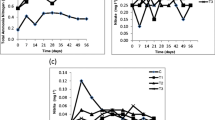Abstract
A 45-day experiment was conducted for standardization of water flow rate for koi carp (Cyprinus carpio var. koi) and gold fish (Carassius auratus) along with water spinach (Ipomoea aquatica) in water recirculating aquaponic system. Different flow rates, viz., 0.8, 2.4, and 4 l min−1, were assigned as T1, T2, and T3, respectively, with stocking density ratio of 1:2 for koi carp and goldfish. Treatment T1 showed maximum fish growth in terms of percentage weight gain and specific growth rate. Plant height, percentage height gain, and yield of water spinach plants were observed highest in treatment T1 as compared to T2 and T3. All the treatments effectively removed nutrients, but treatment T1 showed maximum percentage of nutrient removal (NO3-N, PO4-P, and K). The plant growth and nutrient removal were increased with decrease in flow rate. Flow rate in T1 (0.8 l min−1) showed the highest growth in both fish species. Thus, 0.8 l min−1 can be suggested as optimum water flow rate for the polyculture of koi carp and goldfish with water spinach in an aquaponic system.

Similar content being viewed by others
References
Buttner JK, Soderberg RW, Terlizzi DE (1993) An introduction to water chemistry in freshwater aquaculture. Northeastern Regional Aquaculture Center, University of Massachusetts, Dartmouth North Dartmouth Massachusetts, 170, pp 1–4
Colt J (2006) Water quality requirements for reuse systems. Aquacult Eng 34(3):143–156
Eaton AD, Franson MAH (2005) Standards methods for the examination of water and wastewater, 21st edn. American Public Health Association, Washington DC
Endut A, Jusoh A, Ali N, Nik WS, Hassan A (2009) Effect of flow rate on water quality parameters and plant growth of water spinach (Ipomoea aquatica) in an aquaponic recirculating system. Desalin Water Treat 5:19–28
FAO (2014) Small-scale aquaponic food production. Integrated fish and plant farming. FAO Fisheries and aquaculture technical paper 589
Fu H, Xie B, Ma S, Zhu X, Fan G, Pan S (2011) Evaluation of antioxidant activities of principal carotenoids available in water spinach (Ipomoea aquatica). J Food Compos Anal 24:288–297
Gothberg A, Greger M, Bengtsson B (2005) Accumulation of heavy metals in water spinach (Ipomoea aquatica) cultivated in the Bangkok region, Thailand. Environ Toxicol Chem 21:1934–1939
Hargreaves JA, Tucker CS (2004) Managing ammonia in fish ponds. SRAC Publication, 4603, pp 1–7
Lennard WA, Leonard BV (2004) A comparison of reciprocating flow versus constant flow in an integrated, gravel bed, aquaponic test system. Aquacult Int 12(6):539–553
Losordo TM, Masser MP, Rakocy J (1998) Recirculating aquaculture tank production systems an overview of critical considerations. SRAC Publication, 451, pp 1–5
Perry LM (1980) Medicinal plants of east and southeast Asia. MIT Press, Cambridge, Attributed properties and uses, p 620
Prasad KN, Shivamurthy GR, Aradhya ZSM (2008) Ipomoea aquatica, an underutilized green leafy vegetable: a review. Int J Bot 4:123–129
Rakocy JE, Bailey DS, Shultz C, Thoman ES (2004) update on tilapia and vegetable production in the uvi aquaponic system. University of the Virgin islands Agricultural experiment station, Kingshill, pp 1–15
Shete AP, Verma AK, Tandel RS, Prakash C, Tiwari VK, Hussain T (2013) Optimization of water circulation period for the culture of goldfish with spinach in aquaponic System. J Agric Sci 5(4):26–30
Stone NM, Thomforde HK (2004) Understanding your fish pond water analysis report, cooperative extension program. University of Arkansas at Pine Bluff, United States Department of Agriculture, pp 1–4
Umar KJ, Hassan LG, Dangoggo SM, Ladan MJ (2007) Nutritional composition of water spinach (Ipomoea aquatica Forsk.) leaves. J Appl Sci 7:803–809
Watson CA, Hill JE, Pouder DB (2004) Species profile: koi and goldfish. SRAC Publication, 7201, pp 1–6
Wurts WA, Durborow RM (1992) Interactions of pH, carbon dioxide, alkalinity and hardness in fish ponds. SRAC Publication, 464, pp 1–4
Acknowledgments
This work was supported and funded by Indian Council of Agricultural Research, New Delhi, India. The authors are grateful to Dr. W. S. Lakra, Director, Central Institute of Fisheries Education, Mumbai, India, for providing all the necessary facilities for this research.
Author information
Authors and Affiliations
Corresponding author
Rights and permissions
About this article
Cite this article
Nuwansi, K.K.T., Verma, A.K., Prakash, C. et al. Effect of water flow rate on polyculture of koi carp (Cyprinus carpio var. koi) and goldfish (Carassius auratus) with water spinach (Ipomoea aquatica) in recirculating aquaponic system. Aquacult Int 24, 385–393 (2016). https://doi.org/10.1007/s10499-015-9932-5
Received:
Accepted:
Published:
Issue Date:
DOI: https://doi.org/10.1007/s10499-015-9932-5




